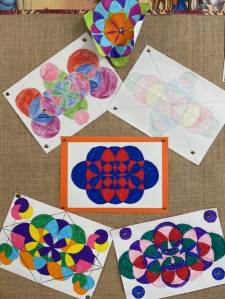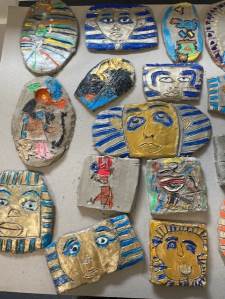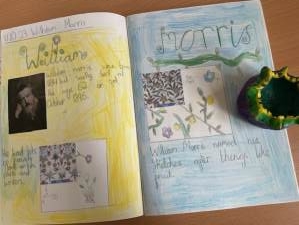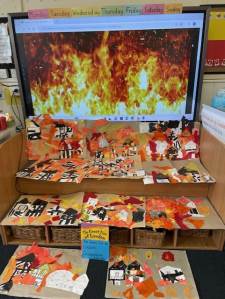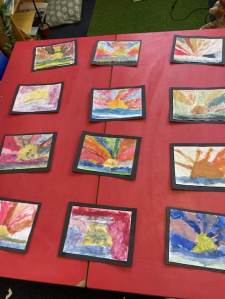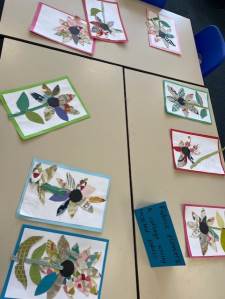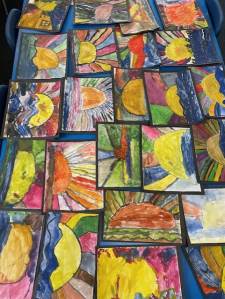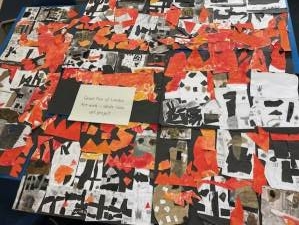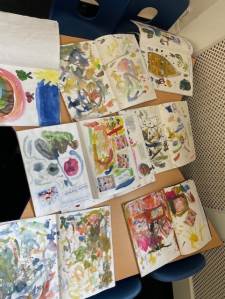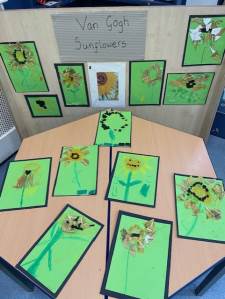Art
UNCRC ARTICLE 29: Education must develop every child’s personality, talents and abilities to the full. It must encourage the child’s respect for human rights, as well as respect for their parents, their own and other cultures, and the environment.
UNCRC ARTICLE 31: Every child has the right to relax, play and take part in a wide range of cultural and artistic activities.
UNCRC ARTICLE 13: Every child has the right to find out and distribute information and to express their ideas – through talking, writing, art or any other form of expression.
At Glusburn School we believe...
Our curriculum leader is Mrs Carla Donald
Glusburn Art Exhibition 2024
Intent
At Glusburn School, we believe that art lessons will engage, inspire and challenge all children to think innovatively and develop creative understanding. Our aim is to allow children to express their individual interests, thoughts and ideas alongside building resilience, confidence and critical-thinking skills. We equip our children with the knowledge and skills needed to experiment, invent and create their own works of art. They should also know that art and design both reflect and shape our history, and contribute to the culture, creativity and wealth of our nation.
Implementation
Children experience 3 alternate half-terms of art each year, this allows them sufficient time to become fluent in their knowledge and skills to create final pieces of work, whilst recalls will ensure this is embedded in their long term memory. The art curriculum at Glusburn school is taught through the progression of art and design techniques using a range of media and materials. Where possible, creative ideas for our art work link to other curriculum areas such as history or geography. Children learn the skills of drawing, painting, textiles, 3D work and digital art and are given opportunities to explore and evaluate different creative ideas. In art lessons children are expected to be reflective and evaluate their work, thinking about how they can make changes and keep improving. Children are encouraged to take risks and experiment and then reflect on why some ideas and techniques are successful or not.
How does the art curriculum reflect our school values and ethos?
At Glusburn School we believe that through the art and design curriculum, the children will recognise that art comes from all walks of life and from every corner of our planet. Our children will know that creativity comes in many different forms and that though we do not always agree on what is the best form, we will agree that everyone has a voice and an opinion about the art that they are either creating or looking at, but will critique the art with respect.
UNCRC ARTICLE 29: Education must develop every child’s personality, talents and abilities to the full. It must encourage the child’s respect for human rights, as well as respect for their parents, their own and other cultures, and the environment.
We want our children to see art and design as an outlet for creativity as well as positive well-being and wellness, in our ever changing world. We aim to nurture the natural talents of our children and celebrate those talents and successes.
UNCRC ARTICLE 31: Every child has the right to relax, play and take part in a wide range of cultural and artistic activities.
UNCRC ARTICLE 13 Every child has the right to find out and distribute information and to express their ideas – through talking, writing, art or any other form of expression.
How does the art curriculum impact on children’s cultural capital and in becoming well rounded citizens?
The study of great artists is developed over time and children gain knowledge and appreciation for a wide range of local and global artists of merit. Through the art curriculum at Glusburn School, our children will know that they are entering a diverse world and that they can add to that diversity with their own creative thoughts and passions. They will know that art and creativity can be an invaluable tool to promote wellness and positive mental health as they face the rigors of the modern world.
Special Educational Needs and Disability
We recognise that pupils with SEND have a range of different needs and starting points. Some of our pupils have severe, complex or profound needs that have a significant impact on their cognitive development, especially the way that they are able to make alterations to their long-term memory. Teachers are ambitious for all pupils including those with SEND, developing and adapting the curriculum so that it is coherently sequenced to all pupils’ needs, starting points and aspirations for the future; acquiring the knowledge and cultural capital they need to succeed in life.
UNCRC ARTICLE 23: A child with a disability has the right to live a full and decent life in conditions that promote dignity, independence and an active role in the community.
Additional Links
Click on the links below to see Padlets of art work produced by our children:
Progression of Drawing at Glusburn School
Year 6 Henry Moore Shelter sketches
Year 3 Egyptian Clay tablets 2022














